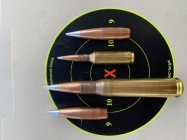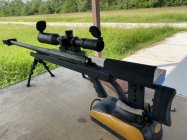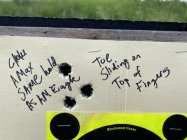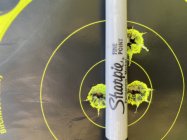I will humbly accept advice from anyone, I just tried to narrow the particulars a bit. When I first shot F Class in FTR I quickly got frustrated with all there was to learn and moved on to F Open. My scores improved but after a couple years I knew the equipment was responsible for my progress. So I went way back and started playing with a couple faux M40-A3 type rifles with Harris bipods. It was fun and I learned a lot.
Fast forward to today and I have a much bigger challenge along the same lines, sort of? I purchased an Armalite AR-50A1 50 BMG. Wow what a surprise. I broke the barrel in according to the owner's manual and progressed to testing some hand loads. To say I was shooting 8" groups at 100 yards would be generous. The rifle has a very effective brake on it so it doesn't kick, but pushes I guess and hits everything beside and behind with muzzle blast.
I upgraded the bipod and trigger so the rifle itself is really good as far as I'm concerned and I have a load the gave ES of 12 and SD of 5.1 so equipment is good. My groups have improved but I have commonly experienced large vertical dispersion, sometimes two close together in one spot and another two close together higher, by maybe 4" while my horizontals are 1 1/2".
I have been concentrating on fundamentals, staying on the gun despite the big boom, loading the bipod, etc. I struggled with proper eye relief initially because the rifle is so tall, I found that I need to elevate my chest with my trigger arm, similar to a sling shooter. I saw David Tubbs shooting that way on a video of KO2M. I am almost always left of the target when the rifle settles and I have been shifting my body left to compensate but it doesn't always help.
I am using a Protektor rear bag with bunny ears. It has a hard bottom and is soft enough that I can squeeze it to adjust for elevation requirements. The ears did seem to be grippy, so the last time out I tried the dryer sheet trick on the ears and that seemed to help the butt slide.
I tried real hard to be consistent the last time with the rifle pointing a couple inches high and a couple inches right on the target. This got me really close after I shouldered the rifle and got my proper eye relief, cheek weld. After squeezing the bag for final adjustment I tried to let everything settle to see if I maintained proper NPA, then just held the bag to keep it from collapsing during recoil.
I shot pretty well that day with a group of 4 of 1 1/4" and the flyer at 1" higher and 2" right. I also discovered that session that I could squeeze the trigger without a firm hold on the grip. I guess I was looking to see what influenced what. I'm making good progress but it is a little expensive to shoot so my practice sessions need to be purposeful.
Please offer any advice you think appropriate. I will say that I don't know what is considered the NPA when shoulder position, cheek weld, and squeezing the bag all enter into sight alignment. Also, using a tight hold on the grip might help with torque reaction of the rifle?
Thanks,
Richard
Fast forward to today and I have a much bigger challenge along the same lines, sort of? I purchased an Armalite AR-50A1 50 BMG. Wow what a surprise. I broke the barrel in according to the owner's manual and progressed to testing some hand loads. To say I was shooting 8" groups at 100 yards would be generous. The rifle has a very effective brake on it so it doesn't kick, but pushes I guess and hits everything beside and behind with muzzle blast.
I upgraded the bipod and trigger so the rifle itself is really good as far as I'm concerned and I have a load the gave ES of 12 and SD of 5.1 so equipment is good. My groups have improved but I have commonly experienced large vertical dispersion, sometimes two close together in one spot and another two close together higher, by maybe 4" while my horizontals are 1 1/2".
I have been concentrating on fundamentals, staying on the gun despite the big boom, loading the bipod, etc. I struggled with proper eye relief initially because the rifle is so tall, I found that I need to elevate my chest with my trigger arm, similar to a sling shooter. I saw David Tubbs shooting that way on a video of KO2M. I am almost always left of the target when the rifle settles and I have been shifting my body left to compensate but it doesn't always help.
I am using a Protektor rear bag with bunny ears. It has a hard bottom and is soft enough that I can squeeze it to adjust for elevation requirements. The ears did seem to be grippy, so the last time out I tried the dryer sheet trick on the ears and that seemed to help the butt slide.
I tried real hard to be consistent the last time with the rifle pointing a couple inches high and a couple inches right on the target. This got me really close after I shouldered the rifle and got my proper eye relief, cheek weld. After squeezing the bag for final adjustment I tried to let everything settle to see if I maintained proper NPA, then just held the bag to keep it from collapsing during recoil.
I shot pretty well that day with a group of 4 of 1 1/4" and the flyer at 1" higher and 2" right. I also discovered that session that I could squeeze the trigger without a firm hold on the grip. I guess I was looking to see what influenced what. I'm making good progress but it is a little expensive to shoot so my practice sessions need to be purposeful.
Please offer any advice you think appropriate. I will say that I don't know what is considered the NPA when shoulder position, cheek weld, and squeezing the bag all enter into sight alignment. Also, using a tight hold on the grip might help with torque reaction of the rifle?
Thanks,
Richard



















